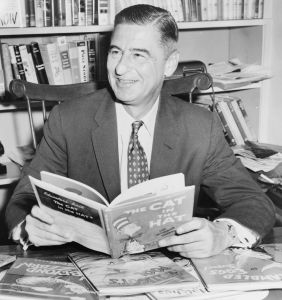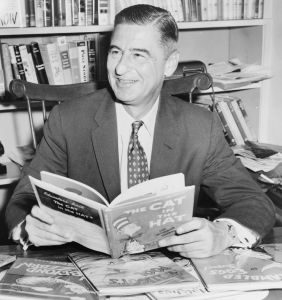A Closer Look at Dr Seuss


Before becoming a household name, Theodor Seuss Geisel, born in Springfield Massachusetts in 1904, had a full career as an advertising illustrator.
While studying at Dartmouth College, Geisel adopted the pen name “Dr Seuss”. He went on to create illustrations for advertising campaigns for Vanity Fair, and LIFE magazine. Geisel also successfully mounted ad campaigns for Standard Oil, as well as Flit Bug Spray. Older readers will no doubt recall that campaign’s catch phrase “Quick Henry, the FLIT” which became part of popular culture in the 1930’s. Subsequent clients included General Electric, NBC, Standard Oil, and the Narragansett Brewing Company.
Geisel’s first Dr. Seuss book was And to Think That I Saw it on Mulberry Street Published (1937 Vanguard Press). That was quickly followed by The 500 Hats of Bartholomew Cubbins, (1938 Vanguard),The Seven Lady Godivas, (1939, Random House), The King’s Stilts, (1939, Random House), and Horton Hatches an Egg, (1940, Random House).
As World War ll geared up Geisel turned to political cartoons. His criticism of Hitler, Mussolini and isolationists like Charles Lindberg cemented his reputation as a liberal Democrat. Never one to shy away from political issues, he cleverly embedded his views in his stories for children: The Lorax (1971), about environmentalism and anti-consumerism; “The Sneetches” (1961), about racial equality; The Butter Battle Book (1984), about the arms race; Yertle the Turtle (1958), about Hitler and anti-authoritarianism; How the Grinch Stole Christmas! (1957), criticizing the materialism and consumerism of the Christmas season; and Horton Hears a Who! (1954), about anti-isolationism and internationalism.
One of Geisel’s most famous books The Cat in the Hat (1955) was taken up as a challenge to make first grade reading primers more engaging for young readers, and to introduce new vocabulary in an engaging way. By the end of his life over 600 million copies of Dr Seuss books had been sold, translated into more than 20 languages.
Geisel’s drawing style is easily recognized with his somewhat rounded and droopy figures, and avoidance of straight lines and right angles.
Four Dr. Seuss drawings will be featured in our January 25th sale.
Three of the pieces in this auction feature personal messages drawn in his distinctive style, and signed. The first is a ‘Best Wishes’ note.
The second is a small illustration of a ‘special’ green egg for Ron.
The third personal note is a Happy Birthday drawing featuring a flying birthday cake.
The fourth drawing is a sketch (possibly for a book cover) of Bartholomew and the Oobleck.
All four pieces are signed Dr. Seuss